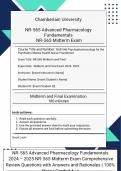Chamberlain University
Chamberlain University
NR- 565 Advanced Pharmacology
NUR 546 Psychopharmacology
Fundamentals for the
Psychiatric-
NR-Mental Health Nurse
565 Midterm ExamPractitioner
NUR 546 Final
Course Title and Number: NUR 546 Psychopharmacology for the
Course Title and Number:
Psychiatric-Mental NUR Practitioner
Health Nurse 546 Psychopharmacology for the
Psychiatric-Mental Health Nurse Practitioner
Exam Title: NR 565 Midterm and Final
Exam Title: NUR 546 Final
Exam Date: Midterm and Final Exam 2024- 2025
Exam Date: Final Exam 2024- 2025
Instructor: [Insert Instructor’s Name]
Instructor: [Insert Instructor’s Name]
Student Name: [Insert Student’s Name]
Student Name: [Insert Student’s Name]
Student ID: [Insert Student ID]
Student ID: [Insert Student ID]
Midterm and Final Examination
Final
180Examination
minutes
180 minutes
Instructions:
Instructions:
1. 1.Read each
Read eachquestion carefully.
question carefully.
2. 2.Answer
Answerallall
questions.
questions.
3. 3.Use the
Use provided
the providedanswer
answer sheet toto
sheet mark your
mark responses.
your responses.
4. 4.Ensure all answers are final before submitting the
Ensure all answers are final before submitting the exam.
exam.
Good
GoodLuck!
Luck!
NR- 565 Advanced Pharmacology Fundamentals
2024 – 2025 NR- 565 Midterm Exam Comprehensive
Review Questions with Answers and Rationales | 100%
,Pharmacokinetics - Answer>> The process by which
drugs are absorbed, distributed within the body,
metabolized, and excreted.
Pharmacodynamics - Answer>> The study of what the
drug does to the body
Factors Affecting Drug Absorption - Answer>> Rate of
dissolution
Surface area
Blood flow
Lipid solubility
pH partitioning
Factors Affecting Drug Distribution - Answer>> Blood
flow to tissues
Ability to exit the vascular system
Blood-brain barrier
Protein-binding capacity
What is used to calculate a patient's overdose risk? (An
actual calculation won't be done
on the exam) - Answer>> To assess a patient's
overdose risk, healthcare professionals often use a
combination of risk factors and clinical tools. The
following factors and tools are commonly used:
Risk Factors:
Patient history of substance use (including opioids or
other medications)
,Concurrent use of other sedatives or depressants (e.g.,
benzodiazepines, alcohol)
History of mental health disorders, especially
depression or anxiety
Dosage of prescribed opioids (higher doses increase
risk)
Age and medical comorbidities (e.g., liver, kidney
disease)
History of overdose or substance misuse
Clinical Tools:
Opioid Risk Tool (ORT): A quick self-report
questionnaire that helps predict the likelihood of opioid
misuse.
Risk Index for Overdose or Serious Opioid-induced
Respiratory Depression (RIOSORD): This tool uses
factors like age, medication dose, and comorbidities to
assess overdose risk.
Prescription Drug Monitoring Programs (PDMPs): These
databases track prescriptions for controlled substances,
helping providers identify patterns of misuse.
By assessing these factors, providers can determine if a
patient is at high risk for overdose and take appropriate
precautions, such as prescribing naloxone or offering
addiction counseling.
Which schedule drugs can APRNs prescribe? -
Answer>> DEA license will allow for prescribing of
Schedules 2-5. There can be restrictions as noted in
collaborative agreement. May be facility/state
dependent.
Who determines and regulates prescriptive authority? -
Answer>> Determines: Also known as independent
prescribing. APRNS can prescribe without limitation and
is state dependent. Includes "legend" (prescription) and
controlled drugs, health/medical services, DME, etc.
, Regulates: State board of nursing, regulated by health
professional board. Federal government controls drug
regulations but has no control over prescriptive
authority.
How does limited prescriptive authority impact patients
within the healthcare system? - Answer>> Limited
prescriptive authority creates numerous barriers to
quality, affordable, and accessible patient care. For
example, restrictions on the distance of the APRN or PA
from the physician providing supervision or
collaboration may prevent outreach to area of greatest
need. An increase in patient waits.
What are the key responsibilities of prescribing? -
Answer>> The ability to prescribe medications is both
a privilege and a burden. Have a documented provider-
patient relationship, do not prescribe medications to
family or friends or yourself, Document a thorough
history and physical examination, include any
discussions you have with the patient about risk
factors, side effects, or therapy options, have
documented plan regarding drug monitoring or
titration, if you consult additional providers not that you
did so. Use the references provided in the following
boxes to assist in safely and rationally choosing one
medication over another.
Be sensible, accept responsibility, do not fear it, know
constraints and limitations, always learn and update,
keep Rx pads in safe place, confirm allergies, verify
medication list with patient, do not let insurance dictate
quantity of Rx, Charting is key (particularly with off
label use), Provide use and rationale.
What should be used to make prescribing decisions? -
Answer>> The best way to keep your patients (and
yourself) safe is to be prudent and deliberate in your




